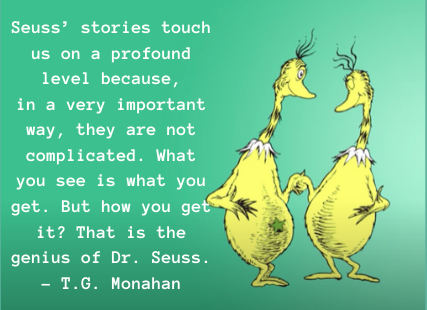
THE VILLAGE (2004)
May 12, 2020District 9 (2009)
June 25, 2020“THE SNEETCHES”
PERFECT STORIES
“THE SNEETCHES”[1]
Theodore Seuss Geisel, better known by his pen name “Dr. Seuss,” is a true national treasure. In addition to his magical poetry and flights of whimsical fantasy, belying an imagination as wide as the universe itself, Seuss’ stories touch us on a profound level because, in a very important way, they are not complicated. What you see is what you get. But how you get it? That is the genius of Dr. Seuss.
Seuss has the ability to convey important moral lessons without lecturing, moralizing, boring, or insulting his audience. You know “How the Grinch Stole Christmas” is about personal redemption and Christmas being a thing of the heart rather than of the wallet, but riding along as the Grinch learns this himself, rather than telling us in didactic form, allows us to experience this character’s arc: from loneliness and pain, to a sinister plan and action, and finally to revelation. Same is true of “Horton Hatches the Egg” on the topic of dependability, “Horton Hears a Who” for tolerance, and “Green Eggs and Ham” for opening one’s self to new experiences. While there is no magic to these lessons and concepts themselves, the magic lies in Seuss’ unique, one-of-a-kind ability to convey them humorously but pointedly so that, in the end, we feel we have lived vicariously through his characters and learned them ourselves.
“The Sneetches,” like most of Seuss’ works, takes the form of a fable, the defining elements (more or less) of which are brevity, animals as stand-in for human characters, and a moral lesson in the end. Pretty much everyone is acquainted with fables, so I won’t go into any real depth deconstructing them. A good synopsis of the structure of fable is here: http://webfronter.com/ealing/literacy/menu3/Narrative_text_types/fables.html.
However, even if plot takes a back seat to moral argument, that is not to say that the latter is unstructured. To the contrary, there is a right (and a wrong) way to make a moral point, and that is to show the consequences of one’s failure to grasp the moral lesson in question, and the journey he or she must undertake before that privation is realized and amends made. Once again, John Truby shows us how it’s done. Again, rather than reinvent the wheel, I will simply refer the reader to Truby, this time to Chapter 5, which begins on page 108.
In addition to being so topical and relevant in a world struggling daily with tolerance for and acceptance of differences in others, I chose “The Sneetches” because it is, to me, the perfect distilled essence of moral argument conveyed in story form (and because my son watches this video about, oh, maybe 800 times a day, so I’m very familiar with it). I won’t go into any long diatribes about “collective narcissism,” although that it precisely what, in my opinion, is at play in this story. I won’t—although I am ever so tempted—launch any political polemics about opportunistic grifters taking advantage of superiority and inferiority complexes in a public with money to burn. I would also caution the reader against trying to find “heroes,” “villains,” “good” guys, and “bad” guys in this story. While it is, essentially, a moral allegory, having read this story and seen its video many times since my own childhood, it is amazing to me how morally complex it really is, and how, depending on your perspective in life, each of the three main characters (or groups of characters), can seem more or less aggressor and victim.
Plot and Moral Argument[2]
Values and moral weakness(es): From a narrator, we learn that there are 2 types of sneetches: star-belly sneetches and plain-belly sneetches, and the former look down on and ostracize the latter. Here, I think it is crucially important to understand that although the star-bellies have superiority complexes, and the plain-bellies have inferiority complexes. Plain-bellies, we are told, “wish their bellies had stars;” i.e., they aspire to be star-bellies, NOT they wish that they were treated equally or accepted for their difference. In other words, both sneetches have internalized the hierarchical system associated with this arbitrary distinction.
Moral need(s): BOTH sets of sneetches need to learn to accept each other as equals, regardless of superficial differences.
Inciting incident/first attack by fake ally-opponent: McBean promises to give the plain-bellies stars, if they pay him. McBean, the opportunistic grifter, casts himself as the answer to their problems by giving them stars, thereby affirming the hierarchical system they’ve bought into, whereas a more honest “fix-it-up chappy” might take a different approach, such as helping them understand that superficial differences don’t matter.
First immoral act: The former plain-bellies get belly stars and assert their equality to the original star-bellies. Yes, this is an “immoral act,” even if done by the sad-sack underdog plain-bellies, because they’re buying further into (and thus deepening) an unjust system, even if they are not consciously aware of it.
Second attack by fake ally-opponent: McBean promises to eradicate the original star-bellies’ stars, if they pay, in order to sustain their illusion of superiority vis-à-vis the new star-bellies.[3]
Second immoral act: The original star-bellies, their stars removed, reassert their superiority vis-à-vis the new star-bellies. The original “elite” up the ante, in the process revealing the true nature of the system all along: it was never about stars or lack thereof, it was about maintaining a privileged class and an underclass.
Battle: A pandemonium of sneetches changing their stars ensues, in a desperate attempt to maintain or aspire to positions of privilege, until their money is exhausted.
Apparent defeat: McBean relishes his “victory,” leaving the sneetches high and dry and penniless, laughing that they are incorrigible. As with any political revolution (American, French, Russian, etc.), the old system needs to bottom out and reveal its flaws before a new and better system can replace it.
Moral self-revelation: Having all hit rock-bottom and seeing how arbitrary a hierarchy based on stars always was, the sneetches realize that there was never anything inherently superior about having a star.
Moral decision: All sneetches learn to co-exist, accepting the randomness and meaninglessness of stars.
* * *
While brevity is a defining characteristic of a fable, it is worth observing that brevity is, in almost all cases, a thing to be aspired to when creating your stories. As I wrote in my previous post about Young Sherlock Holmes, cutting a story down to its essentials almost always makes it better, even if some plot points end up on the cutting-room floor. Those omissions will leave an indelible echo, which only engage your reader/viewer further. With “The Sneetches,” Dr. Seuss drives the moral argument home in a neat, precise, easily-digestible manner, which a longer, run-on story might have marred or come across as too didactic. The point: less is (usually) more. Don’t be afraid to kill your darlings.
If you are interested in an in-depth assessment of a project you are working on, or to retain my services as a developmental editor, please feel free to comment below or e-mail me at toddgmonahan@live.com.
And finally, as I cannot wish you happy writing, since writing so often is decidedly not happy, I wish for you that that tiny light at the end of the tunnel gets a little bit brighter every day.
T. G. Monahan
[1] From Dr. Seuss, The Sneetches and Other Stories (1961)
[2] These scenes are taken from the video version, which is the first story on Dr. Seuss on the Loose (1973) (https://www.imdb.com/title/tt0134628/). I feel the video version lends itself better to analysis than Seuss’ original written story, although they are essentially identical.
[3] Two interesting points here. First, notice that McBean charges the second group more money ($10) than the first group ($4). My guess is that he does this either because the original star-bellies have more money, on account of them having always been the “elite,” or because their despondency is more acute (fear of loss is a greater motivator than hope of gain). Second, when the first original star-belly enters the machine, he says, “Here’s ten for the boy and ten for me,” and is seen pulling the child into the machine. This makes clear that original star-bellies inculcated, and continued to inculcate, their notion of superiority in the younger generation; i.e., prejudice is not inherent, but programmed and passed down.

